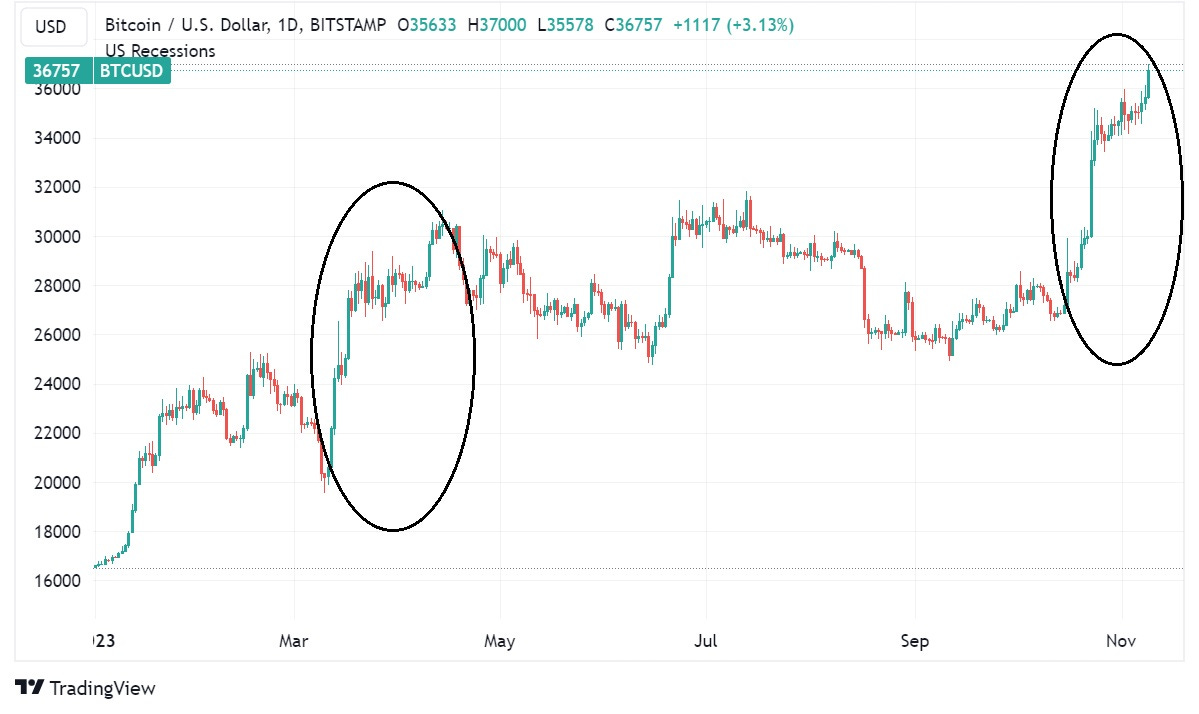WEEKLY, Nov 11, 2023
this BTC move is different, tokenization is not a key narrative, stunning photos
Hello all, and happy 11/11!! Regular readers will know that I do love date-inspired symmetry. 😀 Setting my alarm for 11 minutes past 11 tonight, just so I can squeal and jump up and down.
You’re reading the free weekly edition of Crypto is Macro Now, where I update and/or re-share a couple of things I wrote in more detail about during the week. If you’re a premium subscriber, you’ve probably already read them, so feel free to scroll all the way down for some cool non-crypto links.
If you’re not a premium subscriber, I hope you’ll consider becoming one! You’ll get a daily update as to the crypto and macro trends that I feel are being overlooked, along with some market commentary. There are also charts, links to interesting podcast episodes and long reads, and a running commentary on some of the craziness out there. It’s only $8/month for now, and it would allow me to continue to explore the impact the crypto ecosystem will have on the global economy –this intersection matters, now more than ever.
Follow me on X at @noelleinmadrid where I share photos of gorgeous city I live in, charts, comments on headlines, and, you know, stuff depending on the mood. Also, if you love short daily podcasts, I’m now host of the CoinDesk Market Daily, where I give a brief rundown of crypto and macro markets.
Of course, nothing I say is investment advice!
Feel free to share this with friends and family, and if you like this newsletter, do please hit the ❤ button at the bottom.
Some of the topics discussed this week:
Two notable things about BTC’s recent rise
The Coinbase tea leaves
Crypto leverage is coming back
Top-level stablecoin politics
Crypto assets and stock exchanges
What it would take to stabilize the US government debt
The danger of internet provider centralization
More on how this latest BTC move is different
The breakout market story of the week was definitely ETH, and on Monday I’ll talk more about that and how it could impact overall markets. Meanwhile, here’s what I wrote on Thursday about why the recent BTC moves are particularly interesting:
We know that the BTC price has been up and down but largely up for most of this year so far. And many (including myself) have argued that the pattern we’re in now is different. I’m going to poke a hole in that observation, and then build it back up again.
First, here’s a chart of the BTC performance since January 1.
(chart via TradingView)
The circled areas look pretty similar, right?
Yet look at the dates. The last time BTC had this sort of climb – a sharp jump followed by a more gentle uptrend – was during the March US banking crisis. We’re not in a banking crisis now (I mean, there are some issues, but nothing like March, and nor does a repeat look likely at this stage). This means that it’s not a knee-jerk assumption that the Fed will have to cut rates to bail out the financial system that is driving these moves. Something else is going on.
So, while the wave may look familiar, the water underneath is different. (Ok, so I’m not great at metaphors.)
That’s a big macro difference. Now, on to a significant micro (crypto-specific) difference.
Look at the derivative markets.
The 3-month annualized basis for BTC contract futures is at its highest since the beginning of velodata’s data series in July 2022. In other words, the conviction of futures traders that the price will continue to go up is at its highest in over a year. It’s certainly much higher than in March.
(chart via velodata)
The options market is saying something similar. The difference between the implied volatility of calls vs puts is at its highest since April 2021. In other words, demand for bets the BTC price will continue to go up exceeds demand for bets it will go down by the widest margin in two-and-a-half years.
(chart by Amberdata via CoinDesk)
So, while BTC has seen similar patterns in recent months, this latest price jump is different. Something else is going on. Things are still fragile on the macro stage, but micro indicators are pointing to a meaningful sentiment shift.
Tokenized real world assets should NOT be a key narrative
I was on a Twitter Spaces this past Monday in which some participants insisted that the “main” narrative for crypto markets at the moment was the strong growth in tokenized real-world assets (RWAs). This is disappointing.
The growth is indeed impressive. According to a Dune Analytics dashboard created by 21Shares, the amount of tokenized government bonds has shot up from practically zero at the beginning of the year, to over $600 million today (largely from Franklin Templeton and Ondo Finance). The volume of tokenized credit has risen from $200 million at the beginning of the year, to over $350 million. Tokenized real estate has climbed from around $60 million in January to over $100 million now.
(chart by @21co on Dune Analytics)
But it’s not clear why these particular assets need to be tokenized. With US government securities, there’s not a liquidity advantage – the treasury market is pretty liquid as it is. There’s the fractionalization aspect, which means minimum amounts can be broken up into smaller pieces. But with bond ETFs and money market funds, that’s not an issue with government securities, and anyway, fractionalization is a market structure rather than a technology issue. Real estate is illiquid, and could benefit from tokenization, but has tokenization made a big difference? According to 21Shares, there are only two traded real estate-backed tokens, neither of which have notable trading volume. Same with tokenized credit.
Some insist that banks like the idea of assets that trade 24/7. I know of no banker that likes that idea, and I personally know many that hate it. It’s understandable, having a weekend off makes human resource management much simpler. Even many traders appreciate the cooling-off period the weekend brings.
And settlement speed is not a technology issue, never has been. It’s a regulation issue. True, it’s one that can be streamlined by eliminating the need to check ownership and availability of funds – on the blockchain, that’s trivial and real-time. But for now, most institutional investors don’t have large amounts of money available at a moment’s notice, most have to sell something since leaving funds parked without earning a yield is irresponsible cash management.
Don’t get me wrong, I strongly believe in the potential of blockchain technology to significantly improve how capital markets work. I want to see capital put to better use, and the current system of settlement delay incurs a significant economic cost. But tokenization of a few assets in a niche corner of the market is not going to change that. What will? Allowing stablecoins to be used by regulated financial entities for trade settlement for any type of asset would be a first step.
I also believe that private equity is a field crying out for greater transparency, liquidity and trade efficiency. But there isn’t a lot going on there yet, unfortunately, largely because of regulatory uncertainty.
And I would love to see official support for niche blockchain markets, which in theory could spring up anywhere, bringing liquidity, even if local, to assets and issues that matter to communities, investor groups, jurisdictions, or essentially any group with common interests and/or objectives. Blockchain technology in theory enables the free exchange of assets, without gatekeepers or middlemen. I’m excited about the local or even global value that could unlock.
Going back to the idea that RWAs are the main narrative supporting the crypto market at the moment… um, how exactly do they support the crypto market? Even excluding stablecoins, most tokenized RWAs run on Ethereum, but they only account for less than 7% of total value locked on the network, according to basic math applied to data from 21Shares and DeFiLlama. And a lot of the RWA market cap is not locked in smart contracts on Ethereum, so the relevant percentage is probably much, much lower. It would take a lot more RWA activity to boost the ETH price. I don’t see it happening just yet.
As for RWAs boosting other tokens, I mean, maybe? I don’t know enough about how each RWA is structured to know if growth would trigger more demand for, say, XLM. But even if it would, it still feels more like a “niche” narrative rather than a “main” narrative.
Here’s the downside to focusing on tokenization as a key growth vector for crypto markets today: it’s low-hanging fruit. It’s putting familiar assets onto a new technology to deliver vague benefits. There’s plenty of potential here, but not until the regulators figure out what onchain data they need, what settlement finality means in a bearer asset context, what custody assurances need to be in place, and so on.
So far, it’s the equivalent of the early days of the Internet, when we got excited about uploading PDFs of books and magazines. This was going to kick access onto a new level, it was going to “democratize” learning. And it was indeed a stunning advantage of the Internet, one we have all benefited from. But it didn’t come close to the Internet’s true potential.
Today, the Internet gives us access to video messaging, ride-hailing, no-checkout checkout, connected health monitors, things we could barely imagine two decades ago. Today, the Internet lets me dim my lightbulbs and change their colour, buy my husband’s birthday present with a few clicks, make a reservation at the most-recommended Peruvian restaurant in my neighbourhood, ask ChatGPT to explain the difference between Intel and AMD chips, check my exercise levels for the week, find the right recipe for what I have in the fridge, and I could go on. Reading stuff online is very, very cool, and I appreciate it. But it’s scratching the surface.
I think it’s the same with tokenized real-world assets. Cool, but scratching the surface, and definitely not a “main narrative”. Latching onto that feels like we’re grasping at anything that’s growing. We don’t need to, there are strong narratives propelling the crypto market to greater heights, much more compelling narratives than “let’s bring what already exists today onto the blockchain”. There’s the seizure- and censorship-resistant store of value. There’s the developer platform not owned by anybody. There’s instant cross-border payments, immutable storage, digital ownership that can unlock advantages we haven’t even thought of yet.
This is why labelling RWAs as a “key narrative” is disappointing. It’s good, but it’s the easy part, and its current impact is not what many think it is. As a stepping stone, it’s good – but not as an end objective. It doesn’t change much. How about tokenized equity in a car rental company that can also open the car door? A tokenized municipal bond to pay for a highway that gives you the right to use that highway toll-free? Tokenized gold that can unlock privileges in certain hotels and airport lounges? Now we’re pushing boundaries.
As an ecosystem, we should aspire to a higher level of innovation and big-picture thinking. What is the blockchain equivalent of the utility leaps the Internet has made commonplace today? What are we not yet imagining?
HAVE A GREAT WEEKEND!
Instead of music links today, I’m going to share some photography. Regular readers will know I love powerful landscape images and am constantly blown away by how talented photographers can capture the raw majesty of this world we are lucky enough to inhabit. But today, I’m bringing it closer to “home” and sharing some of the winners and finalists from the 2023 Dog Photography Awards. It feels like a weekend for snuggling, right? Enjoy. And I totally recommend checking out the website, there are so many stunning images.
(photo by Sanna Sander)
(photo by Celine Robel)
(photo by Katie Brockman)
(photo by Stine Grind)
(photo by Karin Bruhin)











